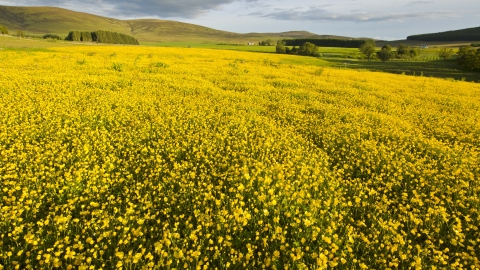

Creeping buttercup seed has been a contaminant in clover, grass and cereal seeds, particularly home saved seed. Seeds are also carried in mud on tyres and boots. Some rodents carry off and store the seeds. Seeds eaten by earthworms have been recovered from wormcasts. Seeds have been found in the droppings of cattle and horses. Seedlings have been raised from the excreta of various birds including the house sparrow.

Most seeds fall around the parent plant but birds eat some of them. Viability was 18% after 1 year under granary conditions. The annual decay rate of seed in soil has been measured at 38%. It made up 36% of the seedbank when pasture was ploughed after 22 years. There is considerable persistence of creeping buttercup seed in the soil under grassland. Up to 12,000 seeds per m² to 15 cm depth have been recorded. Seed dormancy enforced by soil burial leads to a high population of creeping buttercup seeds in the soil seedbank.

Seed buried in undisturbed mineral soil at various depths retained around 50% viability after 20 years. Seed longevity in soil is said to be 5 to 7 years but seed recovered from excavations and dated at 80 years old is reported to have germinated. Stolon production continues into the late summer. In spring new leaves develop and later, just prior to flowering, buds low down on the rosette grow out into stolons that root at the nodes and produce a new crop of daughter plants. The parent plant dies after seed ripening and the daughters overwinter as leaf rosettes. The stolon internodes wither and rot away leaving the daughter plants as independent units. In dry conditions creeping buttercup flowers and sets seeds, in wet conditions it tends to increase by runners.ĭaughter plants form in the axils of the stolon leaves. It normally has a creeping habit under intense grazing or mowing but makes erect growth in taller vegetation. In open and fertile sites, the stolons are long and well branched to ensure rapid colonisation. The stolons begin to develop around the time of flowering. It has a short swollen stem base, long stout adventitious roots and strong leafy, epigeal stolons that root at the nodes. The seedlings are unaffected by frost.Ĭreeping buttercup is a very variable plant. Seedlings rarely develop in established vegetation but on open and disturbed land they often occur in patches or clumps. Adequate soil moisture is important for germination and early growth. Most seedlings emerge from 5 to 30 mm deep in soil. Seedling emergence can occur sporadically throughout the year but the main periods are from February to June and August to October. Ripe seeds are highly dormant and may need a period of after-ripening. Plants from ruderal habitats tend to flower more freely perhaps because seed production is more beneficial in a disturbed situation. A flowering shoot may yield 140 seeds and the average seed number per plant is 687. Not all plants flower and those that do so may have only a few flowers each producing 20-30 seeds. The flowers are insect pollinated, some selfing occurs but cross-pollination predominates. Sometimes the plants do not flower in the first year or flowering is delayed until later in the year, up to October. BiologyĬreeping buttercup flowers from May to August. Creeping buttercup is said to deplete the land of potassium and may have an allelopathic effect on neighbouring plants. However, it can cause diarrhoea in sheep and cattle. Some plants spread widely others remain relatively compact,Īlthough it is usually avoided by stock creeping buttercup is more palatable than the other buttercups and may be grazed. Clones vary in leaf number and this determines the number of primary stolons that are produced. Stolon formation is linked with soil fertility and vegetation cover. A number of varieties have been described that differ in growth habit and flower colour. Plant morphology and growth vary with habitat and grazing pressure. It can tolerate both waterlogging and a moderate drought. It can withstand trampling and compaction and is common in gateways and on paths. On ridge and furrows, it often occurs in a band along the bottom of the furrows. Creeping buttercup occurs on a wide range of soils but forms large colonies on wet, heavy land. It is the commonest of the buttercups and is an efficient colonist of areas disturbed by man and a troublesome weed of arable land. A native perennial common in damp meadows, pastures and gardens throughout the UK.


 0 kommentar(er)
0 kommentar(er)
